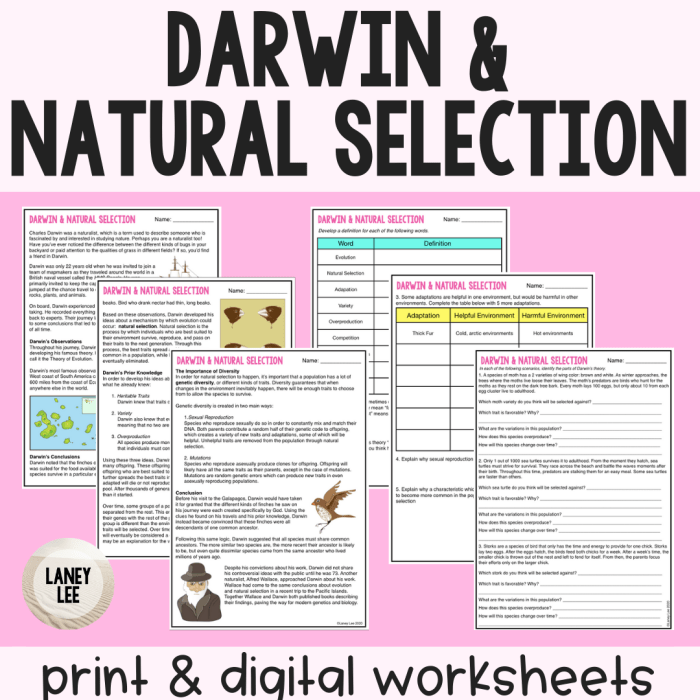The evolution and natural selection worksheet answers provide a comprehensive understanding of the fundamental concepts and principles of evolution and natural selection. This guide delves into the mechanisms of evolution, the role of natural selection in shaping species, and the evidence supporting the theory of evolution.
Through engaging explanations and real-world examples, this guide offers a clear and accessible exploration of the intricate processes that have shaped the diversity of life on Earth.
1. Evolutionary Mechanisms
Evolution is the process by which populations of organisms change over generations through the inheritance of traits. Natural selection is the primary mechanism driving evolution. It occurs when certain traits provide individuals with an advantage in survival and reproduction, leading to an increase in the frequency of those traits in the population over time.
Examples of evolution through natural selection include the development of antibiotic resistance in bacteria, the evolution of longer necks in giraffes, and the development of mimicry in certain species of butterflies.
Genetic Variation and Mutations
Genetic variation is the presence of differences in DNA sequences among individuals within a population. Mutations are changes in DNA that can introduce new genetic variation. Both genetic variation and mutations provide the raw material upon which natural selection can act.
2. Natural Selection in Action
Types of Natural Selection
- Stabilizing selection:Favors intermediate phenotypes, reducing variation around an optimal trait value.
- Directional selection:Favors one extreme phenotype, leading to a shift in the average trait value over time.
- Disruptive selection:Favors both extreme phenotypes, leading to the evolution of two distinct populations.
Influence on Organism Traits
Natural selection can influence various traits of organisms, including size, shape, behavior, and physiological adaptations. For example, natural selection has led to the evolution of camouflage in many species, providing them with an advantage in predator avoidance.
Fitness and Natural Selection
Fitness refers to an individual’s ability to survive and reproduce in a given environment. Natural selection favors individuals with higher fitness, leading to the propagation of advantageous traits within the population.
3. Evidence of Evolution: Evolution And Natural Selection Worksheet Answers

Fossil Record, Evolution and natural selection worksheet answers
The fossil record provides evidence of the evolution of species over time. It shows the progression of changes in anatomical structures and the emergence of new species.
Comparative Anatomy and Homologous Structures
Comparative anatomy reveals similarities in the anatomical structures of different species, indicating common ancestry. Homologous structures are structures that share a common evolutionary origin but may serve different functions in different species.
Molecular Biology and Genetics
Molecular biology and genetics provide further evidence for evolution. DNA and protein sequences show similarities among species, supporting the concept of common descent. Genetic studies can also reveal the genetic basis of phenotypic variation and the evolution of new traits.
4. Applications of Evolutionary Principles
Medicine
Evolutionary principles are used in medicine to understand the evolution of diseases, develop treatments, and predict drug resistance.
Agriculture
Evolutionary principles are applied in agriculture to improve crop yields, enhance disease resistance, and develop new varieties of plants and animals.
Antibiotic Resistance and Genetic Engineering
Antibiotic resistance is an example of evolution in action. The overuse of antibiotics has led to the evolution of resistant bacteria. Genetic engineering is a tool that allows scientists to modify the genetic material of organisms, with potential benefits in medicine and agriculture, but also raising ethical and safety concerns.
Essential FAQs
What is the process of natural selection?
Natural selection is the differential survival and reproduction of individuals with favorable traits in a given environment, leading to the gradual change in the genetic composition of a population over time.
How does genetic variation contribute to evolution?
Genetic variation provides the raw material for evolution by introducing new traits and characteristics into a population. This variation can arise from mutations, genetic recombination, and other processes.
What is the evidence for the theory of evolution?
The theory of evolution is supported by a wide range of evidence, including the fossil record, comparative anatomy, homologous structures, and molecular biology.